In today’s digital world, images are a crucial part of online content. Whether you’re running a website, sharing photos on social media, or sending images via email, the file size of your photos matters significantly. Larger image files can slow down website loading times, consume excessive bandwidth, and take longer to send and download. Learning how to adjust the file size of your photos is essential for optimizing your online presence and user experience. This guide will walk you through the primary methods to reduce photo file size without sacrificing too much quality, focusing on different file formats and compression techniques.
The most common way to reduce the file size of an image is by increasing compression. When you save or export an image using image editing software, you’ll typically encounter options for file formats like JPG, PNG, and GIF. The choices you make in the “Save As” or “Export As” dialog directly impact the level of compression and, consequently, the file size. Higher compression leads to smaller files, which are ideal for faster loading on web pages.
Before diving into compression techniques, it’s important to understand the three main image file formats: JPG, PNG, and GIF, and when to use each for optimal results. If you’re working with photographs or illustrations containing a wide range of colors and smooth gradients, and your priority is to minimize file size, JPG (or JPEG) is generally the best option. However, if you need lossless compression or require transparent areas in your image, PNG-24 is necessary. For simpler graphics with fewer colors and solid blocks of color, GIF or PNG-8 formats are more suitable. Let’s explore how to effectively compress each of these file types to manage your photo file sizes.
Compressing JPG Files: Balancing Quality and Size
JPG compression is the easiest to understand because it primarily revolves around one key factor: quality. When you export an image as a JPG from an image editor, you’ll be prompted to select a quality level. This might be presented as presets like “low,” “medium,” “high,” and “maximum,” a numerical scale (e.g., 0-12, where 0 is lowest and 12 is highest quality), or a percentage (0%-100%, with 100% being the highest quality). The crucial principle is to always choose the lowest quality setting that still meets your visual requirements.
A practical strategy for finding the optimal quality level is to start with a relatively high setting. If the image looks acceptable, gradually reduce the quality in increments. Continue reducing quality until you notice an unacceptable level of image degradation, such as visible pixelation or artifacts. Then, revert to the immediately preceding quality level, which should offer the best balance between visual quality and file size for your needs. Always consider the intended use of the image. For instance, a flower photo intended for a detailed botanical encyclopedia would require higher quality to preserve fine details. Conversely, a flower photo shared casually to celebrate spring can easily tolerate a lower quality setting.
Let’s examine a demonstration using slices of a flower photo exported at six different JPG quality settings to illustrate the impact of compression.
100% Quality, 103 KB File Size
Exporting at 100% quality results in the largest JPG file size and the highest possible quality within the JPG format. This setting is rarely necessary for web use and offers minimal compression.
80% Quality, 48 KB File Size
Reducing the quality to 80% significantly decreases the file size to 48 KB, almost half the size of the 100% quality image. Visually, the 80% setting is nearly indistinguishable from the 100% setting for most viewers.
60% Quality, 28 KB File Size
At 60% quality, the file size is further reduced to 28 KB, a quarter of the original 100% quality file size. Most people would still perceive minimal to no visual difference compared to the highest quality setting. This smaller file size translates to significantly faster loading times.
 Daylily flower and buds at 60% quality
Daylily flower and buds at 60% quality
40% Quality, 17 KB File Size
For many general purposes, a 40% quality JPG image remains perfectly acceptable. The file size is now just 17 KB, making it five times faster to load compared to the uncompressed version.
 Daylily flower and buds at 40% quality
Daylily flower and buds at 40% quality
20% Quality, 12 KB File Size
At 20% quality, noticeable image degradation begins to appear. Blockiness and loss of detail become more apparent, especially in areas with fine textures or gradients.
 Daylily flower and buds at 20% quality
Daylily flower and buds at 20% quality
0% Quality, 7 KB File Size
Exporting at 0% quality results in severe image degradation and blockiness, making the compression artifacts very obvious. This setting is typically unsuitable for most visual purposes, although it achieves the smallest file size of 7 KB.
 Daylily flower and buds at 0% quality
Daylily flower and buds at 0% quality
Sample photo showcasing the impact of JPG quality settings on file size, derived from FCIT’s plant photo collection on ClipPix ETC website.
Another effective technique to reduce JPG file size is to subtly blur the image before compression. Images with fewer sharp edges and fine details compress more efficiently. This is particularly useful for background images, where slight blurring is often unnoticeable or even desirable. You can selectively blur parts of an image to achieve file size savings. Consider the following example of a day lily photo with a detailed background. Compressed at 60% quality, the initial file size is 77 KB.
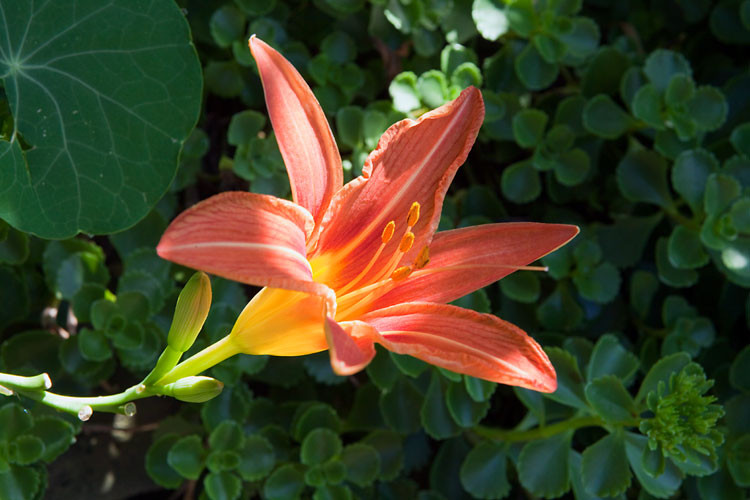 Day lily photo with sharp background
Day lily photo with sharp background
By selectively blurring the background in an image editor like Photoshop, while keeping the day lily flower sharp, and then exporting at the same 60% JPG quality, the file size reduces to only 54 KB. This represents approximately a 30% file size reduction and faster loading times. Furthermore, blurring the background can enhance the artistic appeal of the photo by drawing more focus to the main subject, the flower.
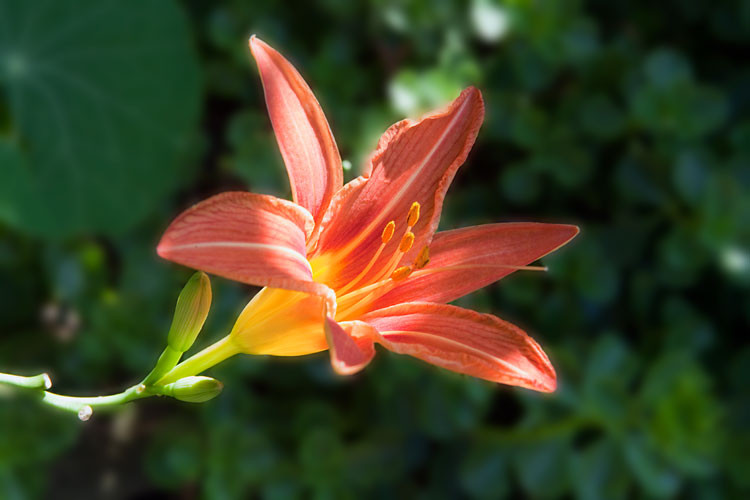 Day lily photo with blurred background for file size reduction
Day lily photo with blurred background for file size reduction
It’s crucial to remember that JPG is a lossy compression format. Each time you save an image as a JPG, you lose some image quality permanently. To prevent cumulative quality loss, always maintain your original image in a lossless format like TIFF or PSD. Export to JPG only for final web use or sharing. Avoid repeatedly saving and re-saving a JPG file, as this will progressively degrade the image quality, similar to making photocopies of photocopies. Always revert to your original, uncompressed file for further edits.
Compressing GIF Files: Color Depth and Simplicity
GIF (Graphics Interchange Format) was traditionally favored for graphics with solid colors and limited color palettes. While PNG-8 now offers similar capabilities with potentially smaller file sizes, understanding GIF compression is still useful.
GIF images are limited to a maximum of 256 colors. However, you can significantly reduce file size by decreasing the color depth, or the number of colors used in the image. For optimal compression, aim for color palettes that are at or just below powers of 2: 256, 128, 64, 32, 16, 8, 4, or 2 colors. For instance, reducing an image with 33 colors to a 32-color palette can yield substantial file size savings, whereas reducing from 32 to 31 colors provides minimal additional compression.
For a deeper understanding of color depth, refer to resources explaining “bit depth” and its impact on image quality and file size.
When saving or exporting as a GIF, the primary settings to consider are:
- Number of Colors: Select the lowest number of colors that still maintains acceptable visual quality.
- Dithering: If you notice unwanted “banding” in areas with color gradients, dithering can help. Dithering introduces a pattern of pixels to simulate colors that are not directly available in the reduced color palette, making gradients appear smoother. The “diffusion” dither pattern usually works effectively.
- Transparency: If your image requires transparent areas, ensure you select the “transparency” option.
Other GIF settings like “Web snap” and “Matte” are largely outdated. “Web snap” was relevant for older monitors with limited color displays and is no longer necessary. The “Matte” setting was used to blend the edges of transparent GIFs with a background color but PNG format now handles transparency more effectively.
GIF has been historically popular for animated images, although PNG is increasingly becoming a viable alternative for animation as well.
 Animated dancing robot GIF example
Animated dancing robot GIF example
Example of a GIF animation, illustrating the traditional use case for GIF format, sourced from FCIT’s robot illustrations collection on the TIM website.
Compressing PNG Files: Versatility with PNG-8 and PNG-24
PNG (Portable Network Graphics) format has gained significant popularity and combines features of both JPG and GIF. It is now widely used across the web, rivaling and potentially exceeding JPG and GIF in prevalence. While PNG compression options might seem slightly more complex initially, mastering them is beneficial for creating efficient web graphics.
The first decision when exporting to PNG is choosing between PNG-8 and PNG-24. PNG-8 is similar to GIF, best suited for graphics with limited colors and solid areas like logos. The key advantage of PNG-8 over GIF is that it typically results in smaller file sizes for similar images. PNG-24, on the other hand, is analogous to JPG, designed for continuous-tone images like photographs or images with more than 256 colors. Unlike JPG, PNG-24 employs lossless compression, meaning no image data is discarded. Consequently, PNG-24 files are generally larger than JPGs but offer superior image quality.
Exporting as PNG-8: The export interface for PNG-8 in graphics programs closely resembles that of GIF. Similar to GIF, you’ll need to specify the number of colors (options typically include 2, 4, 8, 16, 32, 64, 128, or 256), choose whether to apply dithering, and select transparency if needed. The primary benefit of PNG-8 over GIF is the potential for slightly smaller file sizes.
Consider this cartoon example saved as a 32-color GIF with a file size of 13.6 KB.
 Cartoon saved as GIF for comparison
Cartoon saved as GIF for comparison
Now, the same cartoon exported as a 32-color PNG with identical settings yields a file size of only 10.2 KB. This represents a 25% reduction in file size compared to the GIF version while maintaining the same visual quality.
 Cartoon saved as PNG-8 for file size comparison
Cartoon saved as PNG-8 for file size comparison
Example comparing file sizes of GIF and PNG-8 formats for a cartoon graphic, sourced from FCIT’s tech cartoons collection on the TIM website.
Exporting as PNG-24: PNG-24 employs lossless compression, so there are no quality settings to adjust during export. Unlike JPG, no image information is discarded, ensuring maximum image fidelity. However, this lossless nature can lead to larger file sizes.
Here’s a photograph of macaws saved as a PNG-24, resulting in a substantial file size of 400 KB.
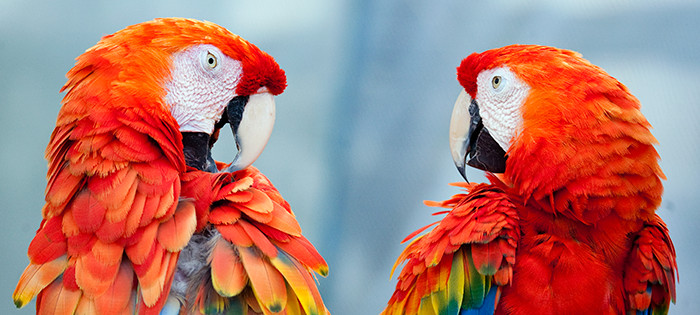 Photo of macaws saved as PNG-24
Photo of macaws saved as PNG-24
The same macaw photo exported as a JPG at maximum (100%) quality has a file size of 259 KB.
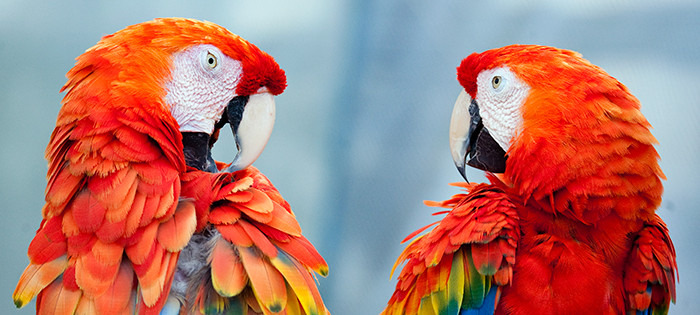 Photo of macaws saved as JPG at maximum quality
Photo of macaws saved as JPG at maximum quality
Further reducing the JPG quality to a high (60%) setting dramatically reduces the file size to a mere 69 KB.
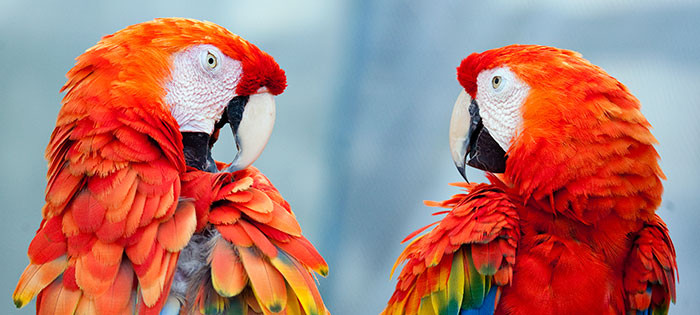 Photo of macaws saved as JPG at high quality
Photo of macaws saved as JPG at high quality
Example demonstrating file size differences between PNG-24 and JPG formats for a photograph, sourced from FCIT’s animal photo collection on ClipPix ETC website.
Considering that PNG-24 files can be significantly larger than comparable JPGs, often five to six times larger, when should you choose PNG-24? There are several compelling reasons to opt for PNG-24 despite the larger file size:
- Transparency: PNG-24 supports transparency, which is essential for images that need to overlay seamlessly on different backgrounds. JPG format does not support transparency.
- Lossless Quality: If preserving every detail of the original image is paramount, PNG-24’s lossless compression ensures no quality degradation. Even at the highest quality settings, JPG compression is lossy and introduces some level of data loss.
- Crispness and Detail: For images containing sharp lines, text, or fine details where JPG compression artifacts are unacceptable, PNG-24 is the preferred choice. Screenshots with small text are a prime example where PNG-24 excels, reproducing text pixel-perfectly without the “smudging” effect often introduced by JPG compression.
Related Resources:
- Understanding the Difference Between Bitmap and Vector Images
- Exploring Bit Depth in Digital Images